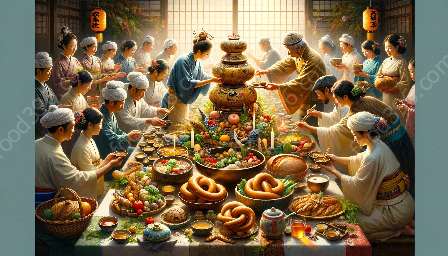When we talk about culinary traditions, we delve into the heart of food rituals, symbolism, and the fascinating history of food culture. Across the globe, food holds a special place in the hearts of people, offering a window into diverse cultures and traditions.
The Rich History of Culinary Traditions
Food has been at the center of human civilization for millennia, from the earliest agricultural societies to the present day. Culinary traditions have evolved over time, shaped by geographic, climate, and cultural influences. The history of food culture is a tapestry woven with the threads of trade, conquest, migration, and innovation.
One of the most intriguing aspects of culinary traditions is the way in which they reflect the history and social dynamics of a particular community. For example, the use of specific spices and ingredients in a cuisine can often be traced back to historical trade routes, colonial influences, or even religious practices.
Food Rituals and Symbolism
Food Rituals:
Food rituals are an integral part of culinary traditions, often serving as a means of fostering community and connection. These rituals can take many forms, from the preparation of special dishes during religious ceremonies to the sharing of meals during family gatherings. The act of coming together to cook and share food can be a deeply meaningful and symbolic experience, strengthening the bonds between individuals and communities.
Food Symbolism:
Food holds rich symbolism in many cultures, often serving as a reflection of beliefs, values, and identity. Certain foods may be considered sacred or auspicious, playing a central role in religious ceremonies or celebratory events. In other instances, specific ingredients or dishes may carry symbolic meanings related to fertility, abundance, or prosperity.
The ways in which food is prepared, presented, and consumed can also be imbued with symbolic significance, with specific rituals and customs dictating proper conduct around the dining table.
Exploring Food Culture Across the Globe
Asia:
In Asia, culinary traditions are deeply rooted in ancient practices and philosophies. Each country in the region boasts its own unique blend of flavors, cooking techniques, and cultural symbolism. From the delicate art of Japanese kaiseki to the complex flavors of Indian curries, the diversity of Asian food culture is a testament to the region's rich history and traditions.
Europe:
European culinary traditions are as diverse as the continent's landscapes and languages. From the hearty stews of Eastern Europe to the refined cuisine of France, each country contributes its own distinct flavors and food rituals to the tapestry of European food culture. The history of food in Europe is marked by a legacy of royal banquets, peasant fare, and the influence of global exploration and trade.
Africa:
The culinary traditions of Africa are as diverse as the continent itself, shaped by a multitude of cultures, climates, and resources. From the vibrant spice markets of North Africa to the savory stews of West African cuisine, the continent's food culture reflects the intersection of tradition and innovation.
Americas:
The Americas are home to a rich tapestry of culinary traditions, influenced by indigenous cultures, European colonization, and global migration. From the maize-based cuisine of Central and South America to the soulful flavors of Southern barbecue, each region has its own unique food culture, deeply intertwined with history, identity, and ritual.
Conclusion
Culinary traditions are a testament to the rich tapestry of human experience, offering a window into the history, symbolism, and rituals of diverse cultures. Exploring the world of food rituals and culture allows us to celebrate the universal importance of food while honoring the unique customs and traditions that make each culinary tradition a rich and meaningful part of human heritage.

